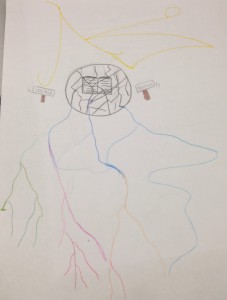Reading Diversity of Islam – Communities of Interpretation F.Daftary
Farhad Daftary, in his essay “Diversity of Islam- Communities of Intepretation” retraces the history of Arabic and Muslim communities and tries to define certain of the differences between the multiples branches of Islam and to explain when and why these differences appeared.
He starts by exposing the first steps of Islam. They were years during which most of the Bedouin tribes of Arabia were united by their pledge to Muhammad, seeing him as “the Messenger of God” (rasul Allah). I tried to represent the union of this newly formed “umma’ (Islamic community) under one leader by writing the name of the Prophet at the top of my drawing. I draw his name in gold to show that he was the light towards which all were turned during the first years of Islamic history.
Then, after Muhammad’s death, the “umma” was fragmented in many subdivisions that Daftary calls “Communities of interpretation”. He argues that these groups took “the form of religio-political movements or schools of thought”. Depending on the political goals of certain ethnicities or groups and their ideals, the populations within the “umma” interpreted the Qur’an in different ways and hold different fundamental ideas about the values constituting Islam. For this reason, I placed a book within a cracked sphere of glass. The book at the center represent the Qur’an but can also be interpreted as a hadith or any writing that is considered essential to the practice and understanding of Islam for a certain community. The sphere has been cracked by two hammers labeled “politics” and “ideals”. I wanted to show that the differences in interpretation of the Scriptures or of Islam among groups stem from these communities’ political views as well as their previous values and beliefs. These variables shape the way they interpret Islam.
From the crack glass flow three main streams which represent the three main branches of Islam: Sunni, Shii and Murija. Each of these movement emerged from different communities of interpretations and were later on subdivided into even smaller groups which did not agree on things like the “definition of true believers”, the “source and nature of authority” (for instance, religious or political authority), “attributes of God” etc. Towards the bottom, thery are plenty of smaller streams; illustrating the diversity of interpretations and communities among Muslims.
I also chose to draw each of these streams in a different color as each of these communities thinks of itself as being on the right path and of the other groups as being “heretics”. For this reason, they are many versions of the “true Islam” which is reflected by the numerous colors in the drawing.

Recent Comments